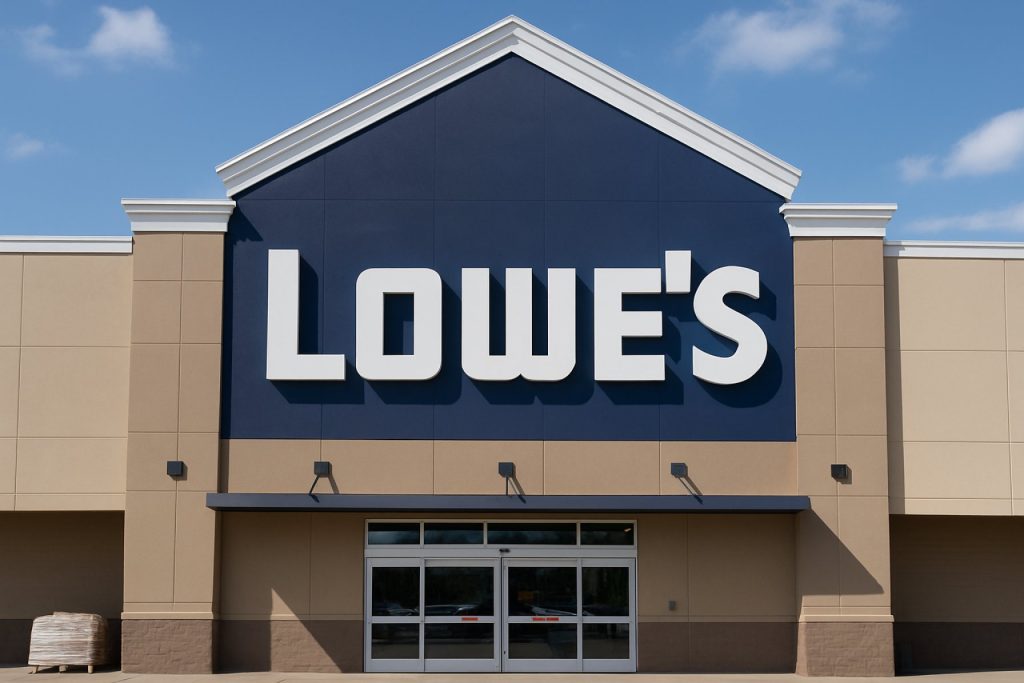
- Lowe’s shares surged 3% premarket as optimism grows despite weak DIY demand and a sluggish housing market.
- Quarterly earnings per share beat forecasts at $2.92, though revenue was slightly below expectations at $20.93 billion.
- Professional contractors and property managers are driving growth, compensating for cautious consumer spending.
- Digital sales are rising, while recent acquisitions like Artisan Design Group aim to strengthen Lowe’s position with builders.
- Full-year sales are projected at $83.5-$84.5 billion, with earnings per share guidance of $12.15-$12.40, reflecting belief in a recovery.
- Lowe’s strategic focus mirrors rivals by targeting trade professionals and investing in technology and customer service to bolster resilience.
Across bustling aisles lined with fresh paint cans and power tools, Lowe’s is quietly staging a comeback that’s captivating Wall Street. On Wednesday morning, the home improvement retailer’s shares shot up nearly 3% in premarket trading—an emphatic signal that investors see hope, even as homeowners hesitate on big-ticket projects.
The backdrop is far from sunny. America’s housing market sits in a holding pattern, squeezed by high interest rates and tepid turnover. Do-it-yourselfers, once the heartbeat of Lowe’s business, are clenching their wallets, pressuring quarterly sales to come in just shy of analysts’ forecasts. Yet, beneath the surface, an unexpected force is fostering resilience: the professional contractor.
- Earnings Per Share: $2.92 (beating expectations)
- Revenue: $20.93 billion (a hair below the $20.94 billion forecast)
CEO Marvin Ellison credits the company’s hard-won stability to a three-part investment: remaking store layouts, overhauling technology, and doubling down on impeccable customer service. “These investments have helped us weather near-term uncertainty and housing market headwinds,” Ellison remarked with characteristic resolve.
While net income dipped from $1.76 billion last year to $1.64 billion, Lowe’s is betting on a robust rebound—projecting full-year sales between $83.5 billion and $84.5 billion. At the high end, that’s a clear step above the prior year, and the company expects flat to 1% growth in comparable sales. Projected earnings per share are similarly optimistic: $12.15 to $12.40 for the year.
What’s driving this cautious optimism?
- Home Professionals Fuel Momentum: Contractors and property managers are ramping up purchases, offsetting lackluster consumer DIY demand.
- Digital Expansion: Online sales soared, showing brisk growth even while bad weather dampened in-person enthusiasm.
- Strategic Acquisitions: The $1.3 billion buyout of Artisan Design Group (a leader in flooring and cabinets for builders) positions Lowe’s to capture lucrative design and installation contracts.
Lowe’s strategy mirrors a trend seen at rival Home Depot, which also reaffirmed its forecast after acquiring major supplier SRS Distribution. Both giants now court the professional trades to buffer against fickle consumer splurges—a deliberate pivot as the home improvement market evolves.
The pay-off? Wall Street, at least for now, seems sold on the story. As the dust settles from a choppy first quarter, Lowe’s stands as a case study in weathering adversity: bold investments, eye on the professional, and a belief that—just maybe—the home improvement party isn’t over yet.
You Won’t Believe the Real Story Behind Lowe’s Comeback—Pros, Cons, and Industry Controversies Revealed!
-
Pro: Strategic Professional Pivot
Lowe’s successfully tapped into the professional contractor market, fueling growth even as DIY consumer spending slowed.
-
Pro: Digital Sales Surge
With online purchases rising sharply, Lowe’s shows adaptability and resilience in the face of changing shopping behaviors.
-
Pro: High-Profile Acquisitions
The purchase of Artisan Design Group expands Lowe’s offerings in flooring and cabinetry for builders, creating new business opportunities.
-
Con: Declining DIY Market
A major challenge is consumer reluctance, as homeowners delay improvements due to high interest rates and stagnant housing activity.
-
Con: Missed Revenue Targets
Despite exceeding earnings per share forecasts, revenue barely fell short—signaling continued uncertainty in core home improvement demand.
-
Limitation: Net Income Dip
Net income slid from $1.76 billion to $1.64 billion year-over-year, illustrating ongoing profit pressures.
-
Controversy: Rival Strategies in Focus
Like Home Depot, Lowe’s is relying heavily on professional customers, raising concerns about long-term consumer engagement and differentiation.
-
Limitation: Housing Market Vulnerability
The success of both Lowe’s and Home Depot remains tightly linked to uncertain housing market trends, making sustained recovery anything but guaranteed.
You Won’t Believe What’s Next for Lowe’s and Home Improvement in the Next Few Years!
-
Pro Contractors Take the Spotlight:
Lowe’s and its main competitor Home Depot are both doubling down on serving professional contractors and property managers. This shift signals a long-term trend: increased investment in pro-centric services, bulk sales, and product assortments customized for professionals instead of just DIY customers.
-
Digital Shopping Explodes:
As seen in the latest quarter, digital sales at Lowe’s are surging. Expect companies to ramp up e-commerce investments, roll out faster shipping, and introduce advanced mobile shopping options—making it easier for both consumers and pros to buy tools and materials from anywhere.
-
Strategic Acquisitions Reshape the Industry:
Following the $1.3 billion acquisition of Artisan Design Group by Lowe’s and SRS Distribution by Home Depot, further consolidation is expected. Companies may buy up specialty firms in flooring, installation, and delivery to expand turnkey service offerings and deepen their hold on lucrative markets.
-
Resilient Earnings Amid Market Headwinds:
Despite tepid housing turnover and high interest rates, Lowe’s projects stable or modestly rising sales. Full-year revenue forecasts in the $83.5–$84.5 billion range reveal confidence that their pro-focused pivot and digital innovations will fuel growth over the next several years—even if the broader housing market cools.
-
Enhanced In-Store Experience:
Remodeled store layouts and cutting-edge technology will continue to improve shopping for both DIYers and professionals. Shoppers can expect more personalized service, smarter product displays, and integrated online-to-offline experiences at stores nationwide.
-
Wall Street’s Watchful Eye:
With shares on the rise and investor optimism strong, the stage is set for heightened stock market attention. Sustained innovation and targeted investments could make Lowe’s and industry peers standout performers in the retail sector for years to come.



